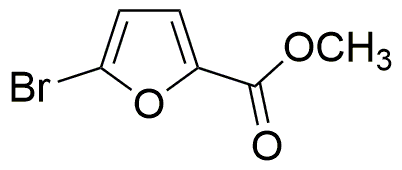Methyl 5-bromo-2-furancarboxylate is widely utilized in research focused on:
- Synthetic Chemistry: This compound serves as a versatile building block in organic synthesis, allowing chemists to create complex molecules efficiently.
- Agricultural Chemistry: It is explored for its potential use in developing new agrochemicals, particularly as a precursor for herbicides or pesticides that target specific plant species.
- Pharmaceutical Development: Researchers investigate its properties for the synthesis of biologically active compounds, which may lead to new medications with improved efficacy.
- Material Science: The compound is studied for its applications in creating novel materials, such as polymers with enhanced properties for use in coatings and adhesives.
- Environmental Chemistry: It is being researched for its potential role in the development of environmentally friendly solvents or reagents, contributing to greener chemical processes.
General Information
Properties
Safety and Regulations
Applications
Methyl 5-bromo-2-furancarboxylate is widely utilized in research focused on:
- Synthetic Chemistry: This compound serves as a versatile building block in organic synthesis, allowing chemists to create complex molecules efficiently.
- Agricultural Chemistry: It is explored for its potential use in developing new agrochemicals, particularly as a precursor for herbicides or pesticides that target specific plant species.
- Pharmaceutical Development: Researchers investigate its properties for the synthesis of biologically active compounds, which may lead to new medications with improved efficacy.
- Material Science: The compound is studied for its applications in creating novel materials, such as polymers with enhanced properties for use in coatings and adhesives.
- Environmental Chemistry: It is being researched for its potential role in the development of environmentally friendly solvents or reagents, contributing to greener chemical processes.
Documents
Safety Data Sheets (SDS)
The SDS provides comprehensive safety information on handling, storage, and disposal of the product.
Product Specification (PS)
The PS provides a comprehensive breakdown of the product’s properties, including chemical composition, physical state, purity, and storage requirements. It also details acceptable quality ranges and the product's intended applications.
Certificates of Analysis (COA)
Search for Certificates of Analysis (COA) by entering the products Lot Number. Lot and Batch Numbers can be found on a product’s label following the words ‘Lot’ or ‘Batch’.
Numéro de catalogue
Numéro de lot/série
Certificates Of Origin (COO)
This COO confirms the country where the product was manufactured, and also details the materials and components used in it and whether it is derived from natural, synthetic, or other specific sources. This certificate may be required for customs, trade, and regulatory compliance.
Numéro de catalogue
Numéro de lot/série
Safety Data Sheets (SDS)
The SDS provides comprehensive safety information on handling, storage, and disposal of the product.
DownloadProduct Specification (PS)
The PS provides a comprehensive breakdown of the product’s properties, including chemical composition, physical state, purity, and storage requirements. It also details acceptable quality ranges and the product's intended applications.
DownloadCertificates of Analysis (COA)
Search for Certificates of Analysis (COA) by entering the products Lot Number. Lot and Batch Numbers can be found on a product’s label following the words ‘Lot’ or ‘Batch’.
Numéro de catalogue
Numéro de lot/série
Certificates Of Origin (COO)
This COO confirms the country where the product was manufactured, and also details the materials and components used in it and whether it is derived from natural, synthetic, or other specific sources. This certificate may be required for customs, trade, and regulatory compliance.

